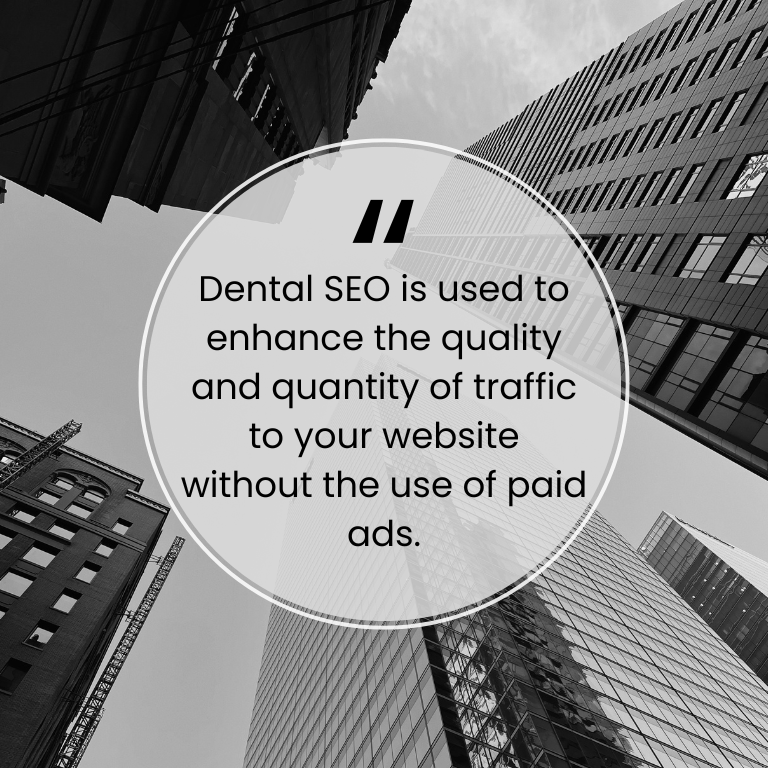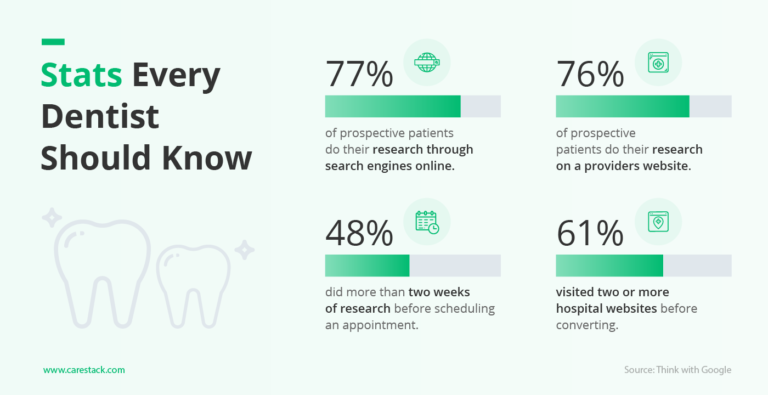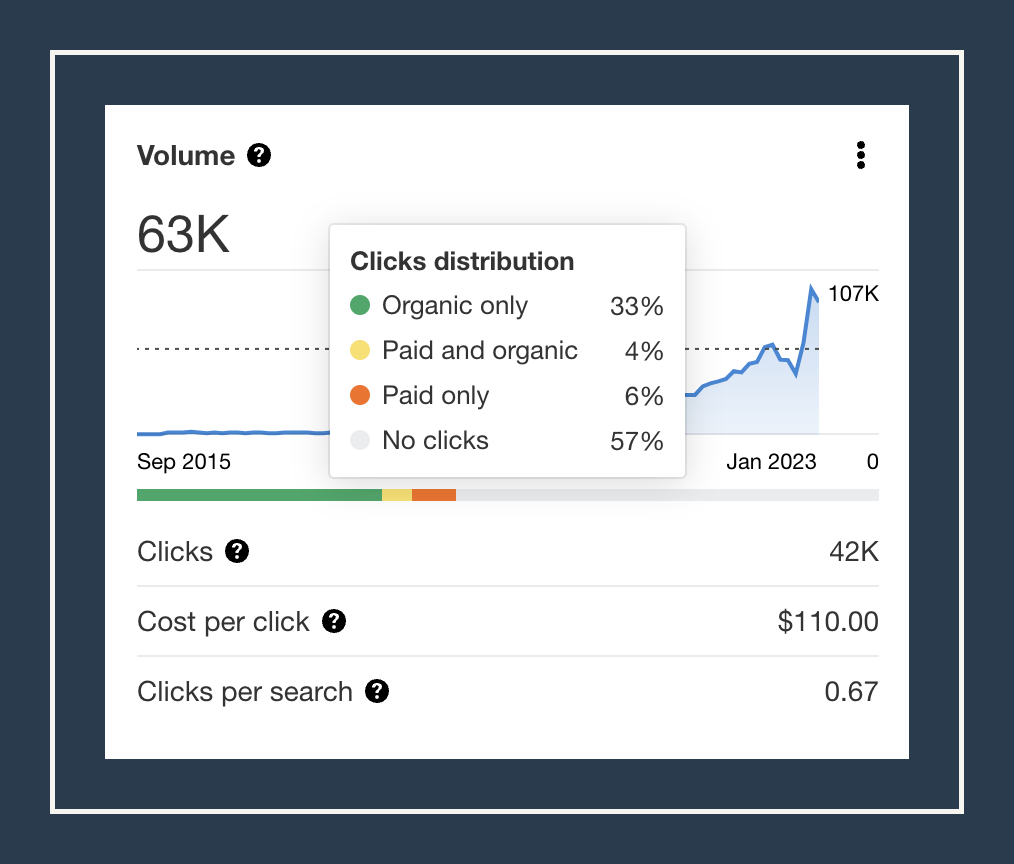
CEO & Founder, Apex Rankings
Dental search engine optimization (SEO) is the process of improving the quality and quantity of your website traffic to a dental practice’s website or a web page from search engines. SEO traffic comes from unpaid (organic) search results rather than direct traffic or paid traffic from channels like Google Ads.
You might be wondering, why is local SEO so important for a dental practice? The answer lies in user behavior. When people need a dentist, they typically start with a search engine like Google. In fact:

You probably know how important it is to be found online. But are you aware just how crucial dental local SEO is for your dental practice? Local SEO helps your practice show up in local searches when potential patients are looking for dental services nearby. Think about it: when someone searches “dentist near me,” you want to be the first name they see.
Google is the go-to for almost everyone. With Google holding over 90% of the market share, it’s no surprise that appearing in the Maps Pack can be a game-changer for your practice. The Maps Pack is that prominent section at the top of Google search results showing local businesses. If you’re up there, you’re golden.
Here’s why local SEO dental marketing is a must for your practice:

Imagine the benefits of dominating local search results. More leads, more traffic, and more patients. Local SEO dental marketing isn’t just an option anymore; it’s a necessity.
Local SEO is crucial for dental practices. It ensures your practice appears when people search for dental services nearby. When someone searches “dentist near me” on Google, you want your practice at the top of the results.
Local SEO involves optimizing your online presence. This includes improving your Google Business Profile, using location-specific keywords, and building local citations. These steps boost your visibility in local searches.
Common local search queries include:
1. “Dentist near me”: A frequent search where you want your practice to appear first.
2. “Dentist [your town]”: Another search that can drive local traffic to your practice.
Local SEO differs from traditional SEO. Traditional SEO aims to improve your website’s ranking globally, while local SEO focuses on your specific area. The goal is to outperform local competitors, not compete with large national dental chains.
By prioritizing local SEO, you attract more relevant traffic. People searching for local services are more likely to book appointments. This leads to increased patient flow and revenue for your practice.

Local SEO offers numerous benefits for dental practices. It’s all about making sure your practice stands out when potential patients are searching for dental services nearby.
Increased Visibility: Local SEO for dentists puts your practice in front of people in your area. When someone searches for a “dentist near me,” you want your practice to be at the top. This increased visibility means more eyes on your business, leading to more potential patients.
Generating New Clients: With local SEO, your Google Business Profile gets optimized, making it easier for people to find you. This means more client inquiries and appointments. Imagine the boost in new patients just from being more visible in local searches.
Targeted Traffic: Local SEO ensures you attract people who are actually looking for dental services. These visitors are more likely to convert into patients because they’re actively seeking what you offer. Your practice gets the right kind of traffic, not just any traffic.
Competitive Edge: In a crowded market, standing out is crucial. Local SEO helps you outperform local competitors by ranking higher in search results. When you’re the first name people see, they’re more likely to choose you over others.
Here’s how these benefits play out in real-world scenarios:
Statistics back this up. For instance, 50% of leads come from Google’s Maps Pack, and the mobile click-through rate for this feature reaches 44%. This means a significant portion of potential patients are using local search to find dental services.
By focusing on local SEO, your practice not only attracts more visitors but also ensures those visitors are more likely to book an appointment. It’s about getting the right people through your door and growing your patient base effectively.
Optimizing your Google Business Profile is key to dominating local SEO. Here’s how you can set up and optimize your profile to attract more local patients.
First things first, you need to have a Google Business Profile. Head over to Google My Business, sign in with your Google account, and search for your practice. If it’s already listed, claim it. If not, add it.
Once claimed, fill out your practice details. Make sure the name, address, and phone number (NAP) are consistent across all online platforms. Add your practice’s category and a business description with relevant keywords.
Google needs to know you’re legit. Verify your business by following Google’s instructions, which might involve a postcard, text, or a video.
Now, let’s make your profile shine:
Encourage your happy patients to leave positive reviews. Respond to all reviews professionally, showing you care about patient feedback. This builds trust and improves your ranking.
Google Posts are a great way to keep your profile active. Share updates, promotions, and news regularly. It keeps your audience engaged and your profile relevant.
For practices looking to increase patient leads through search engine optimization, check out our comprehensive guide on how to get started with search marketing. By following these steps, your Google Business Profile will be optimized for local SEO, making it easier for potential patients to find and choose your practice.
On-page SEO is crucial for making your dental website stand out. When done right, it boosts your visibility and attracts more local patients. Here are some effective on-page SEO tactics to implement.
Creating high-quality content is non-negotiable. You want your website to offer valuable information that answers potential patients’ questions. Think blog posts about dental health tips, service descriptions, and FAQs. The more useful and engaging your content, the better.
Keyword optimization is key. Use tools (like SemRush) to find relevant local keywords that potential patients are searching for. Incorporate these keywords naturally into your content, meta tags, and descriptions. Remember, each page should be targeting one and only one main keyword.
Your meta tags and descriptions should be optimized with local keywords. A compelling meta description can make users click on your link in search results. Make sure it’s engaging and includes a call-to-action.

Your homepage, service pages (veneers, teeth whitening, implants, etc), and contact page are the most important. These should be optimized with relevant local keywords. Make sure your contact information is consistent and easy to find. This not only helps with SEO but also improves user experience.
Creating content that’s both engaging and informative is easier than you think.
By focusing on these on-page SEO tactics, your dental practice will be more visible to local patients searching for services.
User experience is crucial to not only improving your SEO rankings but to convert those visitors into patients.
By focusing on these on-page SEO tactics, your dental practice will be more visible to local patients searching for services.
Off-page SEO is crucial for boosting your dental practice’s online presence. It’s all about activities outside your website that increase visibility, credibility, and search engine rankings.
Local citations are mentions of your practice’s name, address, and phone number (NAP) on various online directories and platforms. Consistent citations help Google recognize your business as legitimate and relevant, improving local search rankings.
Reviews are vital for building trust and credibility. Positive reviews not only attract new patients but also improve your search engine rankings.
Backlinks from authoritative websites signal to Google that your site is trustworthy. This can significantly improve your rankings.
Effective off-page SEO strategies make your practice more discoverable. By focusing on local citations, gathering reviews, and obtaining backlinks, you increase your practice’s visibility and credibility.

Finding the right local keywords can make a huge difference for your dental practice’s SEO. Let’s dive into how you can do it effectively.
First, you need the right tools. Google Keyword Planner is a great start. It helps you see search volumes and get keyword ideas. Tools like Answer The Public show what people are asking about dental services. SEMRush is another powerhouse, offering detailed competitor analysis and keyword tracking.
See what your competitors are ranking for. Tools like SEMRush and Moz let you peek into their keyword strategies. By understanding what works for them, you can identify opportunities for your practice.
Google’s auto-complete feature is really handy. Start typing a keyword related to your practice, and Google will suggest popular searches. These suggestions are gold for finding relevant keywords.
FAQ sections on your website and others’ are treasure troves of keywords. People often search using question formats. Incorporate these into your content to match their search queries.
Long-tail keywords are longer and more specific phrases. They might have lower search volumes but higher conversion rates. Think “best family dentist in [your city]” instead of just “dentist.” These keywords help attract patients ready to book an appointment.
Here are some tips for incorporating these keywords into your content:
By focusing on these strategies, your dental practice can attract more local traffic and convert more visitors into patients.
Building citations is a cornerstone for improving your dental practice’s local SEO. Citations are mentions of your practice’s name, address, phone number, and website across various online directories. These listings boost your visibility and credibility in local searches.
Consistent and accurate citations are crucial. Google relies on this information to verify your business. Inconsistent details can confuse search engines, leading to lower rankings.
Here’s why citations matter:
Accuracy is key. Ensure your practice’s details are the same everywhere. This uniformity helps Google confirm your business is legitimate and relevant.
Common places to list your practice include:
By focusing on building accurate and consistent citations, your dental practice can dominate local search results and attract more patients.

Positive online reviews can be a game-changer for local SEO. They not only build trust but also boost your search rankings. Here’s how to gather and leverage these reviews effectively.
Happy patients are your best advocates. Encourage them to leave positive feedback. Ask them directly after a successful appointment or send a follow-up email with a review request. Make it easy by providing a direct link to your Google Business Profile or Yelp page.
Responding to all reviews, positive or negative, shows you care about patient feedback. Acknowledge positive reviews with a thank you, and address negative ones with professionalism and a willingness to resolve issues.
Showcasing positive reviews on your website and Google Business Profile can build trust and attract more patients. Highlight testimonials on your homepage, service pages, or a dedicated testimonials section.
Positive reviews can improve your search engine rankings. They act as fresh content and signal to Google that your practice is trustworthy and relevant. More reviews can lead to higher visibility in search results.
By focusing on gathering and leveraging positive online reviews, your dental practice can boost its local SEO, build trust, and attract more patients.
Google Search Console is your go-to tool for monitoring and improving your dental website’s performance. It offers insights that help you fix issues, boost your rankings, and attract more patients.
Google Search Console lets you inspect specific URLs on your site. This tool shows how Google views your pages and highlights any errors. Use it to ensure your important pages are indexed and visible in search results.
Indexing problems can prevent your pages from appearing in search results. Google Search Console helps you identify and fix these issues.
With most searches happening on mobile devices, it’s crucial your website is mobile-friendly. Google Search Console identifies mobile usability issues that could hinder your site’s performance.
The data from Google Search Console is invaluable for refining your content and overall SEO strategy. Use performance reports to see which keywords bring traffic and how users interact with your site.
By leveraging Google Search Console, you’ll have the insights needed to continuously improve your dental practice’s online presence.
Quality content is a cornerstone of effective local SEO. When you create engaging, valuable content, it not only attracts more traffic but also boosts your organic search rankings. This is particularly important for dental practices aiming to stand out in local searches.
High-quality content targeting high-value keywords can significantly improve your visibility. Patients are more likely to find your practice when you address their specific needs and queries.
Wondering how to create content that hits the mark? Here are some tips:
Creating content that speaks directly to your audience’s needs builds trust and authority. It makes your practice the go-to source for dental information in your area.
When your content is engaging and informative, it naturally attracts more backlinks and shares. This further enhances your local SEO efforts. For more information on how to effectively engage with your community and create a compelling “About” page, you can visit our sample page for guidance.
Monitoring and measuring the success of your local SEO efforts is crucial. You need to know what’s working and what isn’t, so you can refine your strategy and get better results.
Start by setting up key performance indicators (KPIs). These are metrics that help you gauge your SEO performance. Common KPIs for local SEO include:
Using tools like Google Analytics and Google Search Console is essential. Google Analytics helps you track traffic, user behavior, and conversions. Google Search Console lets you monitor your search rankings and identify any issues with your site.
Regularly review these KPIs to understand your performance. If you see a drop in traffic or rankings, it’s a sign you need to adjust your strategy. Maybe you need to update your content, build more backlinks, or optimize your Google Business Profile.
Communicating these success metrics to stakeholders is important. Whether it’s your team or investors, everyone should know how well your efforts are paying off. Share regular reports that highlight key metrics and any changes in performance. This keeps everyone informed and on the same page.
By consistently monitoring and measuring your local SEO efforts, you can ensure your dental practice stays visible and attracts more patients.
Local SEO is essential for dental practices. It makes sure your practice shows up when patients search for dental services nearby. Optimizing your Google Business Profile is key to standing out in local searches. It involves listing your services, adding quality photos, and collecting reviews.
On-page SEO tactics like high-quality content and keyword optimization boost your website’s visibility. Off-page SEO, such as building citations and gathering reviews, enhances your credibility and rankings.
Here’s a recap of what you need to focus on:
By focusing on these key areas, your dental practice can improve its local search rankings and attract more patients. Keeping track of your SEO efforts ensures you stay visible and competitive in your local market.
© Apex Rankings 2024, All rights reserved | Privacy Policy | Terms of Service | Sitemap
We are excited to announce we are currently developing a brand new website to better enhance our client experience. While the timing is never ideal, its one of those things we must do in order to stay relevant in 2024’s digital marketplace. This landing page has most of our pertinent information, however if you have any questions please book a call or reach out via email!